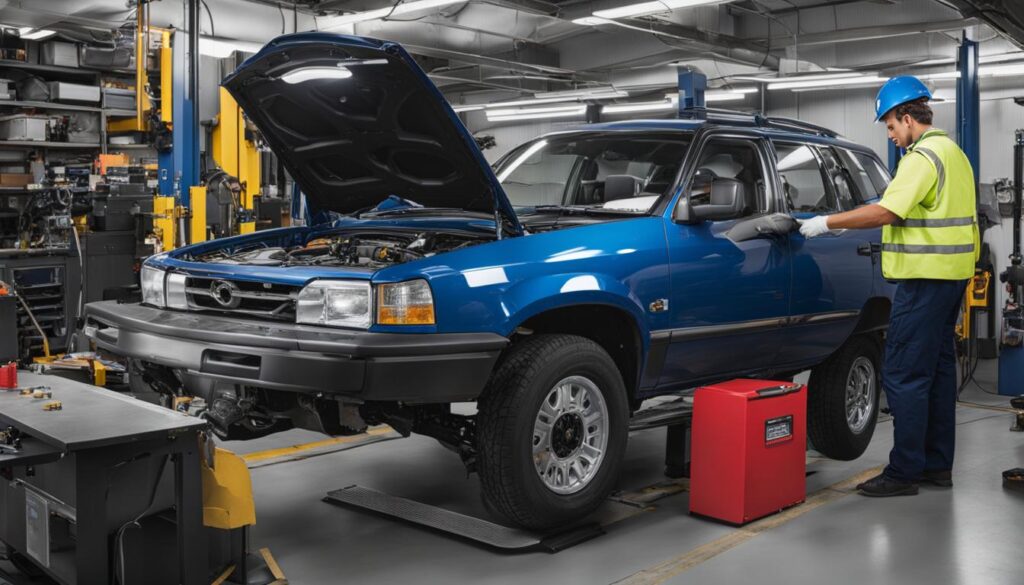Welcome to my comprehensive guide on Understanding New Zealand’s Warrant of Fitness (WOF) and Certificate of Fitness (COF). As a professional copywriting journalist, I will provide a detailed explanation of the vehicle inspections in New Zealand, the compliance requirements for vehicles in New Zealand, and the latest NZ Transport Agency regulations. It is crucial to understand the importance of these regulations in maintaining vehicle safety standards in the country.
Key Takeaways:
- WOF and COF are vehicle inspection processes that enforce compliance with the NZ Transport Agency regulations.
- The inspections involve assessing various safety aspects of the vehicles’ structure, equipment, and emissions.
- The compliance requirements are different for WOF and COF inspections, depending on the type of vehicle.
- Regular vehicle maintenance is crucial to meet WOF and COF requirements and maintain ongoing compliance.
- Staying updated with the latest NZ Transport Agency regulations is essential to ensure compliance.
What Is WOF and COF?
As a vehicle owner or operator in New Zealand, it’s important to understand the Warrant of Fitness (WOF) and Certificate of Fitness (COF) requirements. These inspections ensure that vehicles meet specific safety and emission standards, contributing to overall vehicle safety standards in the country.
The WOF is a legal requirement for all vehicles on New Zealand’s roads. It ensures that vehicles meet specific safety and emission standards. On the other hand, the COF is required for certain types of vehicles, such as taxis, rental cars, and heavy vehicles, to ensure they meet higher safety standards.
Both the WOF and COF inspections focus on assessing various safety aspects, including the brakes, suspension, and lighting systems, among others.

It’s important to note that these inspections must be conducted by an authorized inspector and that non-compliance can result in fines or penalties.
Difference Between WOF and COF
As we discussed in the previous section, both WOF and COF are vehicle inspection processes designed to ensure compliance with the NZ Transport Agency’s regulations for vehicle safety standards. However, there are some key differences between the two that vehicle owners and operators should be aware of.
Firstly, the main difference between WOF and COF is the type of vehicles they apply to. WOF is a legal requirement for all vehicles on New Zealand’s roads, whereas COF is only required for certain types of vehicles, including:
- Taxis
- Rental cars
- Heavy vehicles (vehicles with a gross vehicle mass of over 3,500 kg)
Aside from the vehicle type, the extent of safety standards enforced also differs between WOF and COF. While WOF inspections focus on basic safety and emission standards, COF inspections are more extensive and require vehicles to meet higher safety standards.
To illustrate the differences between the two inspection processes, refer to the table below:
| Aspect | WOF | COF |
|---|---|---|
| Brake performance | Check for effectiveness and balance | Check for effectiveness and balance, including service brake and parking brake performance |
| Structural integrity | Check for damage and corrosion | Check for damage, corrosion, and cracks |
| Exhaust emissions | Check for excessive smoke, noise, and fumes | Check for excessive smoke, noise, and fumes, as well as emissions control equipment compliance |
As shown in the table, COF inspections cover additional safety aspects and require a more thorough evaluation of a vehicle’s condition than WOF inspections.
Overall, understanding the difference between WOF and COF is essential for vehicle owners and operators to ensure compliance with the appropriate inspection process. By adhering to the requirements, we contribute to maintaining vehicle safety standards in New Zealand and promoting safer roads for all.

Inspection Process for WOF and COF
Obtaining a Warrant of Fitness (WOF) or Certificate of Fitness (COF) is a mandatory requirement for vehicle owners and operators in New Zealand. The inspection process evaluates whether the vehicle meets specific safety and emission standards as set by the NZ Transport Agency (NZTA).
The inspection process for a WOF typically takes around 30 minutes and involves a comprehensive assessment of various safety aspects of the vehicle. On the other hand, the COF inspection process is more extensive and can take up to several hours, depending on the type of vehicle being inspected.
During the inspection process, the inspector will examine various components of the vehicle, including:
- Brake systems
- Seat belts and restraint systems
- Lights and indicators
- Tires and suspension
- Exhaust emissions
- Windscreen wipers and washers
Regular vehicle maintenance is key to ensuring a smooth WOF or COF inspection experience. This includes checking tire pressure, oil levels, and ensuring all lights and signals are functioning correctly. Keeping a logbook of all vehicle maintenance and repairs is also helpful for tracking when various components were last serviced, helping owners and operators stay on top of necessary maintenance requirements.

Keeping a logbook of all vehicle maintenance and repairs can help ensure a smooth WOF or COF inspection experience.
Compliance Requirements for WOF and COF
The NZ Transport Agency has established specific regulations and compliance requirements for vehicles to pass Warrant of Fitness (WOF) and Certificate of Fitness (COF) inspections. These requirements are mandatory for all vehicles on New Zealand’s roads to ensure the safety of drivers, passengers, and other road users.
Vehicle Structure
One of the primary compliance requirements for WOF and COF inspections is the vehicle structure. This includes the vehicle’s body, chassis, and frame. It must be free from significant damage, excessive corrosion, and other defects that could compromise the vehicle’s structural integrity. The compliance requirements for vehicle structure ensure that vehicles are structurally sound and can withstand the stresses of normal driving conditions.
Safety Equipment
Another significant aspect of compliance requirements for WOF and COF inspections is the safety equipment. Vehicles are required to have specific safety features, including seat belts, airbags, and speedometers, that meet regulatory standards. Compliance with safety equipment requirements ensures that vehicles are equipped to protect occupants in the event of a collision or other accidents.
Emissions
Compliance requirements for WOF and COF inspections also cover emissions. Vehicles must meet certain emission standards to reduce pollution and improve air quality. Compliance with emission requirements ensures that vehicles are not contributing to environmental degradation and air pollution.
Others
In addition to the above-mentioned aspects, compliance requirements for WOF and COF inspections also cover areas such as brakes, lights, steering, and suspension. Vehicles must pass inspections in all these areas to meet the compliance requirements for WOF and COF.

A table summarizing the compliance requirements for WOF and COF inspections:
| Compliance Requirements | WOF | COF |
|---|---|---|
| Vehicle Structure | Yes | Yes |
| Safety Equipment | Yes | Yes |
| Emissions | Yes | Yes |
| Brakes | Yes | Yes |
| Lights | Yes | Yes |
| Steering | Yes | Yes |
| Suspension | Yes | Yes |
It is important to note that failing to comply with any of the compliance requirements could result in a failed inspection, leading to having to undertake necessary repairs before a new inspection.
Understanding Vehicle Safety Standards
As a vehicle owner or operator in New Zealand, it is crucial to understand the importance of complying with vehicle safety standards. These standards have been established by the NZ Transport Agency to ensure that all vehicles operating on New Zealand roads meet minimum safety requirements.
Meeting these standards is essential for maintaining the safety of drivers, passengers, and other road users. Failure to comply with these standards can result in fines, legal penalties, and even accidents. Therefore, it is essential to understand these standards and the aspects of vehicles they cover.
Key Aspects of Vehicle Safety Standards
The most critical aspects of vehicle safety standards that WOF and COF inspections focus on include:
- Vehicle structure: vehicles must have a stable and robust structure that can withstand the stresses of driving, including collisions and impacts.
- Safety equipment: vehicles must be equipped with essential safety features, such as seat belts, airbags, and braking systems, to protect drivers and passengers in the event of an accident.
- Emissions: vehicles must meet specific emission standards to reduce air pollution and promote environmental sustainability.
- Maintaining vehicle safety: regularly maintaining a vehicle is vital to ensure it remains safe to operate. This includes replacing worn-out parts, such as brake pads and tires, and addressing any potential mechanical issues promptly.
Complying with these safety standards is essential for maintaining vehicle safety and reducing the risk of accidents.

“Meeting these standards is essential for maintaining the safety of drivers, passengers, and other road users.”
Importance of WOF and COF in Vehicle Safety
As mentioned earlier, Warrant of Fitness (WOF) and Certificate of Fitness (COF) inspections play a critical role in maintaining vehicle safety standards in New Zealand. Ensuring compliance with the WOF and COF requirements is essential to mitigate any potential safety risks on the road.
Vehicle safety standards cover various aspects, such as vehicle structure, safety equipment, and emissions. The WOF and COF inspections focus on these areas to ensure vehicles meet specific standards and are safe to operate on New Zealand’s roads.
According to the NZ Transport Agency, approximately one-third of road accidents in New Zealand are caused by vehicle-related issues, such as poor maintenance or faulty equipment. Regular inspections and maintenance can help address these issues, reducing the number of accidents caused by vehicle-related problems.
Adhering to the compliance requirements set by the NZ Transport Agency can also prevent costly fines and penalties. Operating a vehicle without a valid WOF or COF can result in significant consequences, including legal action.
The importance of WOF and COF inspections cannot be overstated, as they contribute to improving vehicle safety and reducing accidents on New Zealand’s roads. By prioritizing compliance and vehicle maintenance, we can all play a role in enhancing road safety for everyone.

Maintaining Compliance for WOF and COF
Regular vehicle maintenance is crucial for ensuring compliance with WOF and COF requirements. By doing so, vehicle owners and operators can avoid potential issues and costs, ultimately achieving a smooth and successful inspection experience. Here are some practical tips for maintaining compliance:
- Schedule routine inspections: Regularly inspect your vehicle for any visible defects or damages, such as worn tires or faulty brakes.
- Service your vehicle regularly: Follow the manufacturer’s recommended service schedule to ensure your vehicle operates at peak performance.
- Address issues promptly: If you notice any issues during routine inspections or while driving, such as strange noises or warning lights, address them promptly to avoid larger problems.
By following these tips, you can maintain compliance with WOF and COF requirements, ensuring your vehicle is safe and roadworthy.
Tips for maintaining vehicle safety standards
In addition to maintaining compliance with WOF and COF, maintaining vehicle safety standards is essential for the overall well-being of drivers and passengers on New Zealand’s roads. Here are some tips for ensuring vehicle safety:
- Regularly check and replace tires: Worn or damaged tires can compromise vehicle stability and braking performance, increasing the risk of accidents.
- Check and replace brakes as needed: Properly functioning brakes are essential for safe stopping and control of the vehicle.
- Ensure all lights and signals work: Lights and signals are crucial for indicating intentions on the road and communicating with other drivers.
- Keep a first-aid kit and emergency supplies in the vehicle: In case of an emergency, having a first-aid kit and necessary supplies can be critical in providing aid and helping to prevent further harm.
By following these tips and maintaining compliance with WOF and COF requirements, you can contribute to maintaining high vehicle safety standards in New Zealand.

“Regular vehicle maintenance is not just important for passing WOF and COF inspections, but also for the safety of yourself and others on the road.”
Staying Updated with NZ Transport Agency Regulations
As the NZ Transport Agency continually updates its regulations and requirements, it’s essential to stay informed to ensure ongoing compliance. Failure to comply with these regulations can lead to penalties, fines, and, in some cases, loss of license. To avoid such repercussions, vehicle owners and operators must keep up with any changes that may affect their compliance requirements.
The NZ Transport Agency provides excellent resources for staying updated with the latest regulations and requirements. These include its website, social media channels, and email newsletters. For example, the agency’s website contains a compliance hub with all the necessary information to help vehicle owners and operators ensure compliance with the regulations.

In addition, the agency provides regular updates and alerts via its social media channels and email newsletters, ensuring that subscribers stay ahead of any regulatory changes. I highly recommend subscribing to these channels to stay informed and avoid any surprises that may impact compliance requirements.
Finally, staying in touch with industry associations and other relevant groups that monitor regulatory changes can also provide valuable insights and knowledge. These associations are often well connected and can provide early alerts about any changes that may affect vehicle compliance requirements.
In conclusion, staying updated with the NZ Transport Agency regulations is an essential part of maintaining compliance for WOF and COF inspections. By remaining informed and proactive, vehicle owners and operators can avoid costly penalties and fines and ensure that their vehicles remain safe and roadworthy.
Conclusion
In conclusion, as I’ve explained in this comprehensive guide, understanding New Zealand’s Warrant of Fitness (WOF) and Certificate of Fitness (COF) is crucial for all vehicle owners and operators. By complying with the inspection processes and maintenance requirements, we contribute to maintaining vehicle safety standards and prioritize the overall safety of everyone on the road.
It’s important to remember that WOF and COF inspections play a vital role in maintaining vehicle safety standards in New Zealand. Ensuring vehicles meet safety standards is essential for the well-being of both drivers and passengers. Regular vehicle maintenance is crucial to maintaining compliance with the NZ Transport Agency regulations.
Staying informed about changes to the regulations and requirements set by the NZ Transport Agency is essential for vehicle owners and operators to ensure ongoing compliance. By staying updated, we can address any potential issues promptly and prioritize the safety of everyone on the road.
Thank you for taking the time to read this guide on Understanding New Zealand’s WOF and COF. Remember to prioritize compliance and regular maintenance to keep your vehicle roadworthy and safe for everyone.
FAQ
What is a Warrant of Fitness (WOF) and a Certificate of Fitness (COF)?
A Warrant of Fitness (WOF) is a legal requirement for all vehicles on New Zealand’s roads to ensure they meet specific safety and emission standards. A Certificate of Fitness (COF) is required for certain types of vehicles, such as taxis, rental cars, and heavy vehicles, to ensure they meet higher safety standards.
What is the difference between a WOF and a COF?
The main difference between a Warrant of Fitness (WOF) and a Certificate of Fitness (COF) is the type of vehicles they apply to and the extent of safety standards they enforce. WOF applies to all vehicles, while COF is required for specific types of vehicles that have higher safety standards.
What is the inspection process for WOF and COF?
To obtain a Warrant of Fitness (WOF) or a Certificate of Fitness (COF), vehicles must undergo a thorough inspection that assesses various safety aspects. The inspection process examines key areas of the vehicle and emphasizes the importance of regular maintenance to ensure a smooth inspection experience.
What are the compliance requirements for WOF and COF?
The NZ Transport Agency has specific regulations and requirements in place for vehicles to pass WOF and COF inspections. Compliance requirements cover various aspects of the vehicle, including structure, safety equipment, emissions, and more.
Why are WOF and COF inspections important for vehicle safety?
WOF and COF inspections play a vital role in maintaining vehicle safety standards in New Zealand. These inspections help reduce accidents, ensure roadworthiness, and promote overall safety for all road users.
How can I maintain compliance for WOF and COF?
Regular vehicle maintenance is crucial to consistently meet WOF and COF requirements. It is recommended to schedule routine inspections, servicing, and promptly address any potential issues to maintain compliance.
How can I stay updated with the NZ Transport Agency regulations?
The NZ Transport Agency periodically updates its regulations and requirements. It is important to stay informed about these changes to ensure ongoing compliance. Resources are available to access the latest information.




